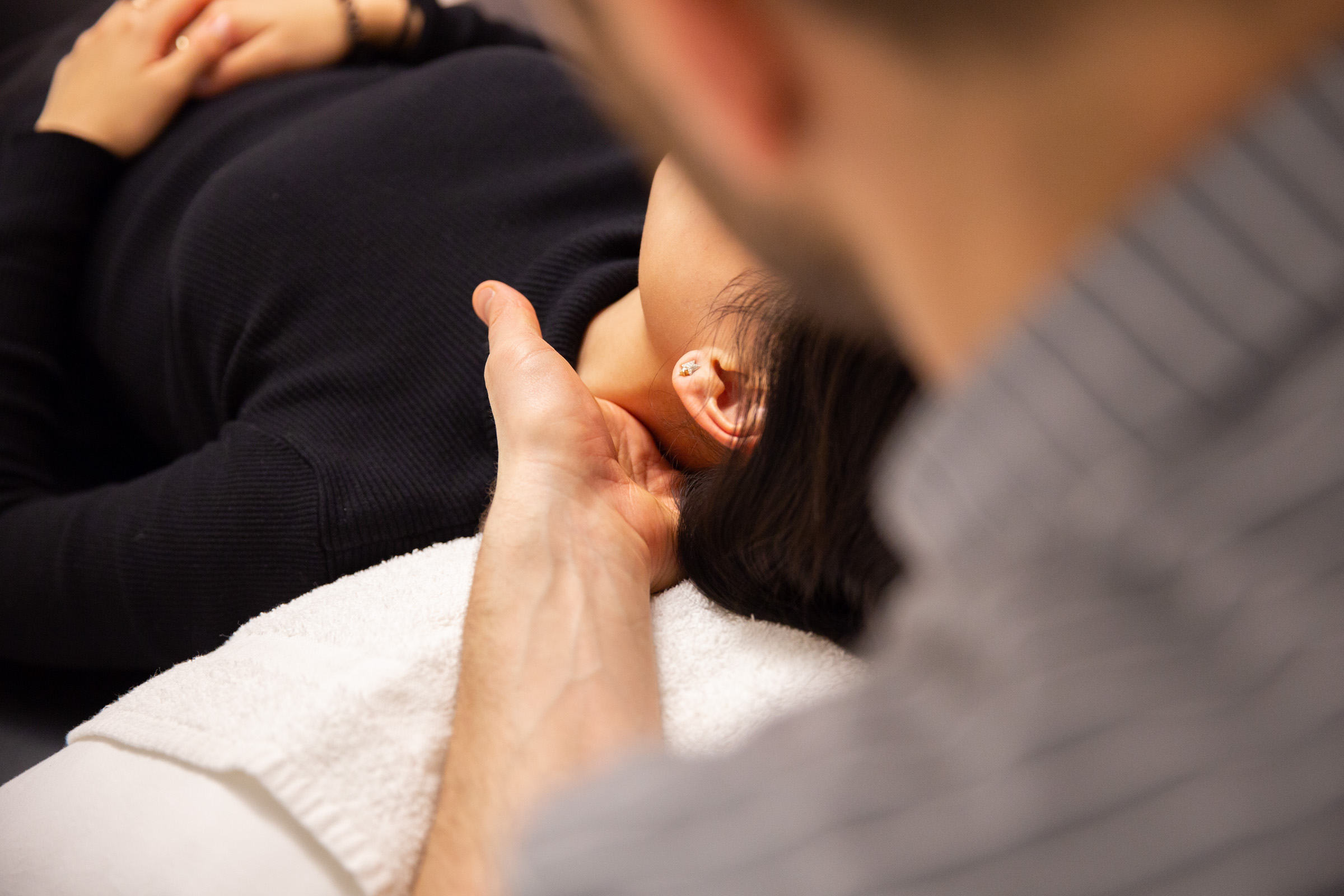In with the new … What should manual therapy look like in a modern physiotherapy practice? (Part 2)
In part one of this exploration, we looked at the pitfalls of manual therapy and the power that language and narratives have to either push patients into these traps or sidestep them completely.
“manual therapy does not cause specific structural tissue changes”
In part two, we’ll explore ideas on how to create a healthy context for manual therapy. We’ll figure out how to use it in a way that’s consistent with modern EBP Physiotherapy.
Let’s start with what we’re doing; manual therapy seems to impart neurologically mediated changes including analgesia and changes in psychology (1). This can help to:
1. Facilitate exercise.
2. Facilitate exposure to a feared movement.
3. Develop a healthy narrative about how pain is readily changeable.
4. Meet patient expectations.
So how do we take advantage of this and at the same time avoid the pitfalls?

The first thing we can do is set the stage of patient expectations. By prefacing a bout of MT with a comment along the lines of: “we’re going to do some manual therapy which may help improve your symptoms and allow you to move better; to be clear, we are not putting anything back in to place or freeing anything up, but simply interacting with the nervous system.”
For many, manual therapy related reductions in pain are often transient and the favourable results are likely attributed to changes in neurophysiology (1), not biomechanical miracles.


It should also be stressed to the patient that manual therapy is being used to decrease sensations such as ‘stiffness’, ’tightness’ or pain in order to facilitate an increase in activity and load tolerance. Finally, and perhaps most importantly, any positive short-term change in pain or function after manual therapy must be used to further reinforce positive messaging in the form of “Explain Pain” style education which may be as simple as suggesting “pain is a protector and not a barometer for tissue damage.”
Some authors have described situations using vignettes to help decide how to use or not use contemporary manual therapy (2). Despite these articles and other research recommendations, the evidence-base is limited and to our knowledge there are only two randomized trials examining the effects of manual therapy combined with a neurophysiological versus a biomechanical/biomedical explanation.
First, a group of subjects with osteoarthritis and evidence of central sensitization were randomized to receive 4 sessions of modern or biomedical pain education in addition to knee joint mobilization before their surgery (3). Pre and post-operative results showed no significant group differences except for one clinically important difference: subjects receiving modern pain neuroscience education (PNE) with manual therapy achieved greater improvements in psychosocial variables (pain catastrophizing, kinesiophobia). Pain catastrophizing and fear of movement are two big predictors of non-recovery (4) and perhaps this study suggests that modern pain education can co-exist with manual therapy without compromising clinical outcomes.
Another study from Louw and colleagues randomized subjects with chronic non-specific low back pain to receive one of two exnations (neurophysiology or mechanical) with manual therapy applied to the lumbar spine (10 minutes of central PA mobilizations - not an intervention that would typically be used in clinical practice) (5). The only significant finding that met the minimal detectable change (MDC) was the group receiving a neurophysiological explanation for their symptoms experienced an immediate change in the straight leg raise test immediately post-treatment.
Unfortunately when we consider these two studies we cannot build much of a compelling argument for manual therapy. Worth a mention though is that manual therapy and PNE did not use an inhibitory learning approach which could be an important component in creating clinically meaningful change. To elaborate a bit, the roots of inhibitory learning come from the psychology literature and it has been adopted into physiotherapy practice, most typically in the treatment of chronic low back pain (6,7). pla
So how does inhibitory learning work? Well the patient first identifies a salient movement, perhaps one where there is pain-related fear (let’s say: forward flexion). They then make a prediction about the outcome (ex. It’s going to be painful) after which an intervention (i.e. a symptom modifier, for example MT) is introduced, followed by re-testing of the movement. If after the intervention the movement has changed (i.e. is less symptomatic) then a prediction error has occurred (i.e. the expectancy violation) which seems to be an important observation to reduce pain-related fear between a coupled stimulus and an expected outcome (8).

This uncoupling of fear of pain, pain, and movement could allow for further graded exposure to fearful activities. It could also lead to a graded path towards more meaningful activities of daily living. What this approach provides is an opportunity for the patient to see in real-time that the painful movement can be changed, which can help to form an expectation of recovery and enhance the therapeutic relationship with the clinician. It is worth noting that these expectancy violations could also be induced by education, advice or movement cues.

One argument against using manual therapy under the inhibitory learning model is that manual therapy and even education could act as an ‘inhibitor’ or a ‘safety signal’ which can disrupt the size, strength and efficacy of the expectancy violation.
What could be more powerful? The patient explores and learns about the symptoms on their own through movement hopefully coming to a self-realization that ‘hurt’ did not lead to some expected ‘harm’ and continue to push the symptom edges from there. Unfortunately many do not take the ‘perceived’ risk of challenging symptoms and end up in avoidance cycles. For a more in-depth review on pain-related fear and inhibitory learning check the brilliant works of Johannes Vlayen, Jeroen de Jong, and Michelle Craske.
PREDICTING PATIENT OUTCOMES
Baseline pain and disability scores are important to collect on the first clinical interaction as they have been shown to be useful prognosticators across many different musculoskeletal populations (9,10,11). However, it may be important to consider what happens within the first few treatment sessions to determine if manual therapy and response to treatment might have predictive capabilities.
Cook and colleagues have looked at the prognostic value of this phenomenon. In a retrospective study, a group of subjects reporting chronic low back pain on average for 345-weeks received four treatments of manual therapy and exercise within a 2-week time period. For those subjects who experienced a pain reduction of 30% within the session, there was a predicted 50% improvement in Global Rating of Change scale and the Oswestry Disability Index at 6-month follow-up (12).

Similarly, another study analysed within and between-session changes in group of subjects with mechanical neck pain who received manual therapy. Those subjects who experienced a within-session change in pain and function of 30% often experienced a 50% reduction in the Neck Disability Index at 96 hours (13). Further, the between-session changes in pain were associated with a 50% change in disability and Global Rating of Change scores at 96 hours (13). These findings may suggest that early positive changes indicate a favorable prognosis, and taking it one step farther may help us identify who is likely to be a rapid, slow, or non-responder to treatment. We must remember that even if dramatic symptom modification does not occur, a favorable outcome is still possible. This point and a good deal more information surrounding symptom modification was recently discussed in an article from Dr. Gregory Lehman (14). One highlight: Dr. Lehman suggests that symptom modification procedures have the potential to reduce pain and improve function, allow an entry point for PNE thereby creating an opportunity to “reduce the impact of negative influences, such as reduced self-efficacy, catastrophizing, [lost] locus of control, fear avoidance, and kinesiophobia.”
A long story short: manual therapy, when used responsibly within a salient context, could have the ability to demonstrate that movement is safe and that change is possible. This gives hope and facilitates an active treatment approach. Manual therapy can remain a part of clinical practice when the clinician stays up to date with current research (15) and can coexist with pain neuroscience education (PNE) even in patients with evidence of central sensitization (16,17).
WHAT WE DO:

We use manual therapy in our practice, but not on every patient. Yes, this means we impart mechanical forces to the skin and the underlying tissue in effort to create a neurophysiological response that may lead to a pain inhibition or even a prediction error. It may also give us some insight into prognostics. We use it with full disclosure to our recipient that an active approach is paramount for recovery and then we also pair it with PNE as appropriate.
As biopsycholosocialist physiotherapists, we check-in with other salient features that may be a part of the clinical picture such as past experiences, sleep, unmanaged chronic stress, diet, negative beliefs, training loads, total life loads, other comorbid conditions, and physical activity habits to name a few. We also look for things the patient is already doing well, highlight them, encourage and positively reinforce it. An acknowledgement of these variables help our patients see the vast complexity of pain. More pragmatically, it serves to highlight the many avenues for change.
In this view, manual therapy falls into the category of symptom modifying procedure (SMP) (alongside: education, repeated movements, isometrics, exercise induced analgesia, etc). It is used to encourage to the uncertain patient that movement, specific exposures and loading is good, and will be part of their recovery. Our choice of whether or not to use it depends on the evidence, patient preferences and expectations, along with our training, and the context of our practice setting.
THE PRACTICE “CONTEXT”
Practice context is often left out of the conversation between pro and anti-manual therapy advocates. Given a context that is publicly funded, with long wait times to see a provider, as well as short treatment sessions, manual therapy clearly falls off the list of priority interventions. We would suggest this hierarchy of interventions:
1. Education - set the expectation for recovery early. Positively reframe the issue as something that will or can change while highlighting the resiliency and adaptability of the human body. Consider “impairments” as opportunities for positive change and not “dysfunctions.”.
2. Exercise - those that are preferred by the patient and supported by evidence for their specific condition, and staged appropriately (i.e. if pain control is needed - initial exercises that focus on SMP; building to exercises that progressively load the body, and provide the patient with “proof” of their resilience).
3. Manual Therapy.
With this triage in mind, manual therapy may be helpful if the context allows sufficient time, when pain control would be useful for reassurance, a positive patient expectation is present, and when using manual techniques that have demonstrated analgesic effects in the literature for the patients presentation (examples - thoracic manipulation for mechanical neck pain (18); mobilizations with movement for lateral elbow pain [19], etc). Typically these practice settings are privately funded. Now, there is an obvious issue here, why use something that hasn’t been shown to consistently change long term outcomes regardless of funding? Please understand, that we do not object to this question. However, in a privately funded setting, patient expectations appear to be very important to assist buy-in and encourage a patient to return to a provider. If the patient does not return because they didn’t receive the passive intervention they expected, there is a risk that they will find someone willing to provide it, and that person may provide a nocebic message and promote dependency. This is a slippery slope of logic and could be used to excuse high volume repeat visits (which we’re not on board with), but this becomes the job of the physiotherapist - to prove to the patient that they don’t need you (the provider) to get better!
THE TAKE HOME MESSAGE
So how can manual therapy be married with the evidence based framework? Given the ideas discussed above, we should:
1. Consider our language when explaining our current understanding of how manual therapy works, to help build positive expectations of recovery. We must remember that all the elements that make us human are at work in how we recover from pain or injury.
2. Leverage any changes in pain or movement tolerance with manual therapy to discuss our current best understanding of pain as relating to protection and sensitivity. Additionally these changes can be used to refute concerns for long standing damage as the cause of pain (“if we can change it for a moment, we change it long-term”), to plant and water the seeds of self-efficacy.
3. Use of manual therapy should be done in a transparent way by informing the patient of its transient effects, and allowing the patient to voice their values as part of the shared decision making process. Such discussions will also help build therapeutic alliance.
If manual therapy is used to aid short-term goals of pain relief, then it should always be paired with an active approach. Additionally manual therapy should be left behind as soon as possible, giving way to a fully active approach designed to help achieve the patient’s long-term goals, which empowers the patient to improve with the tools they have learned during the course of care (appropriate education and progressive exercise loading).
“attributing successful spinal manipulative therapy outcomes solely to the identification and correction of biomechanical faults makes as much sense as crediting a beard for winning a hockey playoff series. - Joel Bialosky”

As a final consideration, why does it feel good to receive a firm handshake or a hug? Is it a coincidence that sports team who provide regular pats on the back or high fives to each other have better performances (20)? Touch is a part of being human and of our evolutionary background. We use touch to explore our environment and to also establish trust, connectivity and cooperation with others. This is social grooming, a behaviour that results in significant reductions in blood pressure, heart rate and other stress responses, something neuroscientists such as Dr. Robert Sapolsky have studied for years.
Using touch paired with words that harm does not mix with our biology. However, therapeutic touch provided by a warm, empathetic therapist that listens, empowers, reassures and instills hope is definitely biopsychosocial-sanctioned.
If we are to continue using manual therapy, the ego must be ‘left at the door’. We are not “fixing” anyone! If leveraged well, manual therapy can demonstrate a form of “proof” to our patient that they are changeable. Let’s be responsible with manual therapy. Let’s stay up to date with science, use positive language, build self-efficacy, use shared decision making and focus on a meaningful active approach.
References:
1) Bialosky et al. The mechanisms of manual therapy in the treatment of musculoskeletal pain: A comprehensive model. Manual Therapy. 2009.
2) Rabey et al. Reconceptualising manual therapy skills in contemporary practice. Musculoskeletal Science and Practice. 2017.
3) Lluch et al. Preoperative Pain Neuroscience Education Combined With Knee Joint Mobilization for Knee Osteoarthritis: A Randomized Controlled Trial. Clinical J Pain. 2018.
4) Luque-Suraez et al. Role of kinesiophobia on pain, disability and quality of life in people suffering from chronic musculoskeletal pain: a systematic review. BJSM. 2018.
5) Louw et al. The effect of manual therapy and neuroplasticity education on chronic low back pain: a randomized clinical trial, Journal of Manual and Manipulative Therapy. 2016.
6) Vlaeyen et al. The treatment of fear of movement/(re)injury in chronic low back pain: further evidence on the effectiveness of exposure in vivo. Clinical Journal of Pain. 2002.
7) Bunzli et al. Making Sense of Low Back Pain and Pain-Related Fear. JOSPT. 2017.
8) Craske et al. Maximizing exposure therapy: an inhibitory learning approach. Behavioral Research Ther. 2014.
9) Chen et al. Trajectories and predictors of the long-term course of low back pain: cohort study with 5-year follow-up. Pain. 2018.
10) Walton et al. Risk factors for persistent problems following acute whiplash injury: update of a systematic review and meta-analysis. JOSPT. 2013.
11) Jakobson et al. Long-term prognosis for neck-shoulder pain and disorders: a 14-year follow-up study. Occupational and Environmental Medicine. 2018.
12) Cook et al. Does early change predict long-term (6 months) improvements in subjects who receive manual therapy for low back pain? Physiotherapy and Practice. 2017.
13) Cook et al. Is there preliminary value to a within- and/or between-session change for determining short-term outcomes of manual therapy on mechanical neck pain? Journal of Manual and Manipulative Therapy. 2014.
14) Lehman, Gregory. The Role and Value of Symptom-Modification Approaches in Musculoskeletal Practice. JOSPT. 2018.
15) Mintken et al. Manual Therapists - Have you lost that loving feeling!?. Journal of Manual & Manipulative therapy. 2018.
16) Louw et al. A clinical perspective on a pain neuroscience education approach to manual therapy. Journal of Manual and Manipulative Therapy. 2017.
17) Nijs et al. Recognition of central sensitization in patients with musculoskeletal pain: Application of pain neurophysiology in manual therapy practice. Manual Therapy. 2010.
18) Cleland et al. Examination of a clinical prediction rule to identify patients with neck pain likely to benefit from thoracic spine thrust manipulation and a general cervical range of motion exercise: multicenter randomized clinical trial. Phys Ther. 2010.
19) Lucado et al. Do joint mobilizations assist in the recovery of lateral elbow tendinopathy? A systematic review and meta-analysis. Journal of Hand Therapy. 2018
20) Kraus et al. Tactile communication, cooperation, and performance: an ethological study of the NBA. Emotion. 2010.

